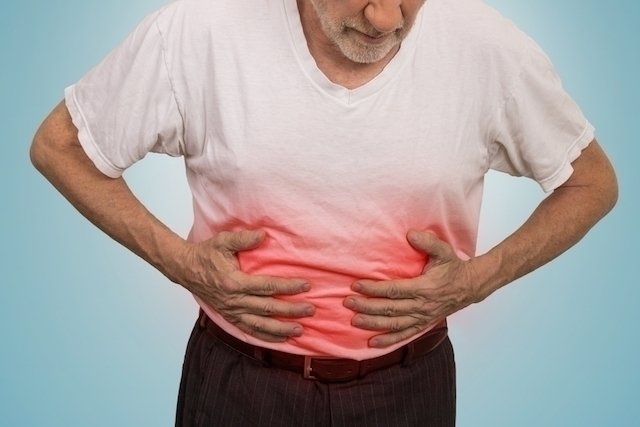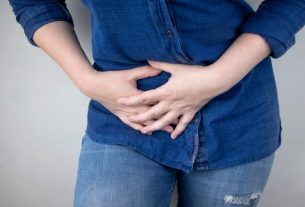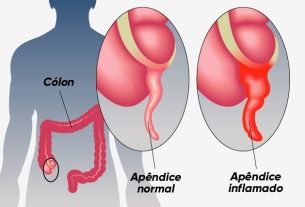Peritonitis is inflammation of the peritoneum, a membrane that surrounds the abdominal cavity and covers the organs in the abdomen. Peritonitis generally results from infection, rupture or severe inflammation of one of the organs in the abdomen, as occurs in appendicitis or pancreatitis, for example.
The most common symptoms of peritonitis include abdominal pain and tenderness, fever, vomiting or constipation, for example. Whenever peritonitis or any other serious change in the abdomen is suspected, it is important to go to the hospital.
The treatment of peritonitis is recommended by a gastroenterologist and depends on its cause, but is generally done with antibiotics and hospitalization, and surgery may also be indicated.

Main symptoms
The main symptoms of peritonitis are:
- Abdominal pain and tenderness.
- Swelling of the abdomen;
- Fever;
- Nausea and vomiting;
- Loss of appetite;
- Sudden diarrhea or constipation;
- Decrease in the amount of urine;
- Excess gases.
The pain caused by peritonitis tends to worsen with movement or when pressing on the region.
How to confirm the diagnosis
The diagnosis of peritonitis is normally made by the doctor through evaluation of symptoms, palpation of the abdomen and physical tests, such as asking the person to stay in a certain position.
Furthermore, to determine the cause, the doctor may also order blood tests that evaluate infections and inflammation, as well as imaging tests such as x-rays, ultrasound or tomography.
Possible causes
There are numerous causes of peritonitis, but the most common include:
1. Appendicitis
Appendicitis is one of the main causes of peritonitis, as the inflammation that occurs in the appendix can extend through the abdominal cavity and reach the peritoneum, especially when it is not quickly treated and presents complications such as rupture or abscess formation. Know how to recognize when abdominal pain could be appendicitis.
2. Gallbladder inflammation
Also called cholecystitis, it generally occurs when a gallstone causes obstruction of the bile duct and then inflammation of this organ. This inflammation must be treated promptly by the doctor, which includes surgery and the use of antibiotics.
If not treated properly, the inflammation of the gallbladder spreads to other organs and the peritoneum, causing peritonitis and other complications such as abscesses, fistulas and the risk of generalized infection.
3. Pancreatitis
Pancreatitis is an inflammation of the pancreas, which causes symptoms that generally include abdominal pain that radiates to the back, nausea and vomiting. If not treated properly, the inflammation can become serious and cause complications such as peritonitis, necrosis and abscess formation, putting the life of the affected person at risk. See more about pancreatitis.
4. Injuries to the abdominal cavity
Injuries to abdominal organs, whether due to ruptures, trauma injuries, complications after surgery or even inflammation, are important causes of peritonitis. This is because injuries can release irritating contents into the abdominal cavity, as well as causing contamination by bacteria.
5. Medical procedures
Medical procedures such as peritoneal dialysis, gastrointestinal surgeries, colonoscopies or endoscopies can cause peritonitis due to complications that may arise, whether due to perforations or contamination of the surgical material.
6. Paralytic ileus
It is a condition in which the intestine stops working and its peristaltic movements cease. This condition can arise after abdominal surgery or situations such as inflammation, bruising, side effects of certain medications.
Symptoms caused by paralytic ileus include loss of appetite, constipation, vomiting or even intestinal obstruction, which in more serious cases can lead to perforation of the intestine, leading to the spread of bacteria that cause peritonitis. Find out more about this disease.
7. Diverticulitis
Diverticulitis consists of the inflammation and infection of the diverticula, which are small folds or sacs that appear in the walls of the intestine, especially in the last portion of the colon, causing abdominal pain and tenderness especially in the lower part of the left side, in addition to diarrhea or constipation. , nausea, vomiting, fever and chills.
Your treatment must be started quickly by the doctor, based on the use of antibiotics, analgesics, changes in diet and hydration, in order to avoid worsening of inflammation and the emergence of complications such as bleeding, formation of fistulas, abscesses, intestinal obstruction and intestinal obstruction itself. peritonitis. Find out everything about diverticulitis.
How the treatment is carried out
The treatment of peritonitis depends on its cause, but it is always advisable to seek medical help as soon as possible so that treatment can be started soon, in order to avoid complications.
Treatment usually involves the administration of antibiotics to treat the infection and prevent the spread of bacteria. At the same time, hospitalization is indicated where analgesics and anti-inflammatories, fluids administered into the vein or oxygen are administered.
Furthermore, if these measures are not sufficient to treat the problem, it may be necessary to undergo surgery to resolve the cause of the inflammation, such as removing the appendix, removing an area of necrosis or draining an abscess, for example.

Sign up for our newsletter and stay up to date with exclusive news
that can transform your routine!
Warning: Undefined array key "title" in /home/storelat/public_html/wp-content/plugins/link-whisper-premium/templates/frontend/related-posts.php on line 12
Warning: Undefined array key "title_tag" in /home/storelat/public_html/wp-content/plugins/link-whisper-premium/templates/frontend/related-posts.php on line 13



